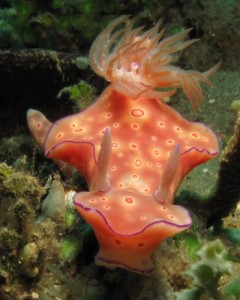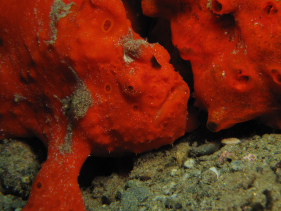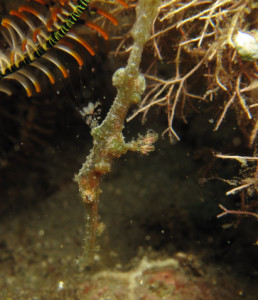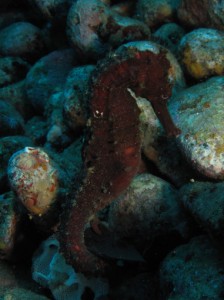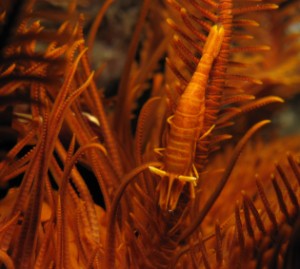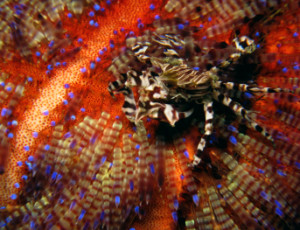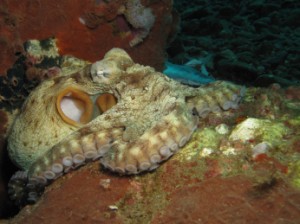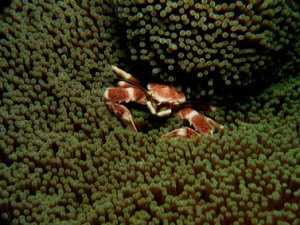News
Creatures of the Muck
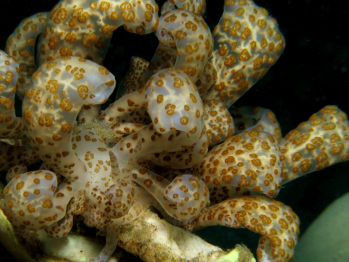
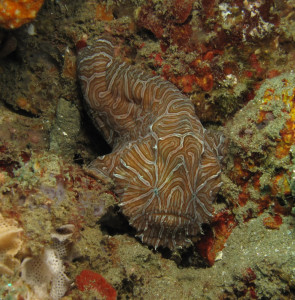 Muck diving. “Le” muck diving. There is no pretty way to say muck diving even if you are French. In fact when you do muck dive for the first time and look out over a silty, sandy slope, or a pile of coral rubble, it seems that a hopeless hour underwater searching for some form of life, including your dive buddies, is ahead. I was especially worried about unfairly judging muck diving at Maluku Divers in Ambon because my trip there immediately followed a boat trip through Raja Ampat which is so full of color and life everywhere. But with a beautiful Balinese meal sitting in front of me at the end of the first day of diving on Ambon, my thoughts were that, perhaps all of the previous 15 days of travel, including three international flights through four countries, two domestic flights, and a liveaboard trip of twelve days, was just to arrive at Maluku Divers on Ambon.
Muck diving. “Le” muck diving. There is no pretty way to say muck diving even if you are French. In fact when you do muck dive for the first time and look out over a silty, sandy slope, or a pile of coral rubble, it seems that a hopeless hour underwater searching for some form of life, including your dive buddies, is ahead. I was especially worried about unfairly judging muck diving at Maluku Divers in Ambon because my trip there immediately followed a boat trip through Raja Ampat which is so full of color and life everywhere. But with a beautiful Balinese meal sitting in front of me at the end of the first day of diving on Ambon, my thoughts were that, perhaps all of the previous 15 days of travel, including three international flights through four countries, two domestic flights, and a liveaboard trip of twelve days, was just to arrive at Maluku Divers on Ambon.
Although we took one of the longest, but most scenic, ways to get to Ambon, once we arrived there, our traveling was over. Our first dive at Laha I, along the southern coast of Ambon Bay, was reported to be an absurdly long interval away from the resort when in fact it took less than five minutes – barely enough time to be introduced to Jamal, our experienced dive guide from Lembeh, Mo our boat driver, and Hafez, a young Indonesian king who helped us with our equipment on the day boat. Topside, this dive site happens to be a small but active wharf area where people seem to both live and work on their boats. The children are especially intrigued by the foreign divers. They wonder why we use our money to travel so far just to see the fish right under their boats.
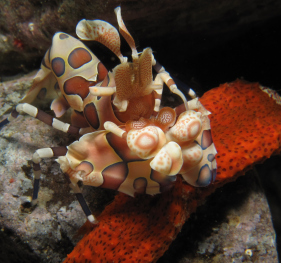 We did a backward roll into the warm water and swam to a pile of rubble directly under the boats. It was noon so I was completely surprised when it was a mandarin fish colony that we were on a mission to observe. My previous encounters with mandarin fish were to watch them having sex at 6:30 in the evening, but they were also busy scampering about at noon, just ignorant of the opposite sex and yet brilliant against their colorless home. I was so focused on getting that perfect photo of a mandarin fish that I almost missed just how many other creatures inhabited this rather small rubble complex. Banded pipefish were just hanging in the water, and very long white antennae revealed the location of the largest banded coral shrimp that I had ever seen. One of the oddest-looking fish, an estuarine stonefish, was lying there like a sunken shipwreck. With the exception of the stonefish that seemed cemented into this habitat, I found it difficult to understand that out of the entire ocean these creatures chose this noisy, close to shore site, and yet they live here together at least during daylight, harmoniously. These were my first 30 minutes in Ambon.
We did a backward roll into the warm water and swam to a pile of rubble directly under the boats. It was noon so I was completely surprised when it was a mandarin fish colony that we were on a mission to observe. My previous encounters with mandarin fish were to watch them having sex at 6:30 in the evening, but they were also busy scampering about at noon, just ignorant of the opposite sex and yet brilliant against their colorless home. I was so focused on getting that perfect photo of a mandarin fish that I almost missed just how many other creatures inhabited this rather small rubble complex. Banded pipefish were just hanging in the water, and very long white antennae revealed the location of the largest banded coral shrimp that I had ever seen. One of the oddest-looking fish, an estuarine stonefish, was lying there like a sunken shipwreck. With the exception of the stonefish that seemed cemented into this habitat, I found it difficult to understand that out of the entire ocean these creatures chose this noisy, close to shore site, and yet they live here together at least during daylight, harmoniously. These were my first 30 minutes in Ambon.
The psychedelic frogfish’s coloring was also a bit of a mystery to me. It is usually obvious why a frogfish looks as it does; generally I am not sure that I have actually seen one when I have seen it because they imitate their habitat so well. Although the overall color of the psychedelic frogfish allows it to blend in with the sand of Ambon, there are vibrant white lines that extend radially from its eyes and then swirl around over the main part of its body. It was not until I read about this fish, where these patterns were shown to parallel those from certain hard corals, that I could begin to see how the fish evolved to mimic its environment. However, the lines also have a sort of hypnotizing affect on the viewer, and perhaps have a dual purpose in distracting as well any prey so that it loses concentration for a moment.
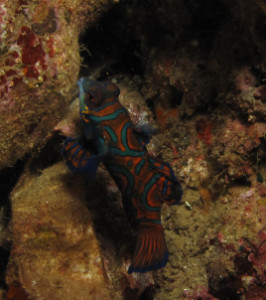 The dives in Ambon rarely went below twenty meters. Only once did I find myself at twenty-five meters and that was to watch a flamboyant cuttlefish that we had inadvertently chased to this depth. Most dives occurred on this same coast, just different sections of it. Even though the landscape was somewhat similar overall, sloping sandy, I was starting to feel that there were different neighborhoods. The Laha dives were where the harlequin and bumblebee shrimp, pipefish, and assorted frogfish lived in the rubble and the sand. Further west, the landscape becomes more covered with corals and especially crinoids. Here there is also a jetty, Air Manis Jetty, where a different lifestyle is in development. There is quite a bit of human refuse where eels and giant banded coral shrimp could find a home. The crinoids here have space to move about the sand like ladies in 17th century ball gowns and were sometimes escorted by a matching ornate or long nosed ghost pipefish. Octopi displayed themselves openly in daylight, and fat nudibranchs were busy chewing the sponges that covered the pilings of the pier.
The dives in Ambon rarely went below twenty meters. Only once did I find myself at twenty-five meters and that was to watch a flamboyant cuttlefish that we had inadvertently chased to this depth. Most dives occurred on this same coast, just different sections of it. Even though the landscape was somewhat similar overall, sloping sandy, I was starting to feel that there were different neighborhoods. The Laha dives were where the harlequin and bumblebee shrimp, pipefish, and assorted frogfish lived in the rubble and the sand. Further west, the landscape becomes more covered with corals and especially crinoids. Here there is also a jetty, Air Manis Jetty, where a different lifestyle is in development. There is quite a bit of human refuse where eels and giant banded coral shrimp could find a home. The crinoids here have space to move about the sand like ladies in 17th century ball gowns and were sometimes escorted by a matching ornate or long nosed ghost pipefish. Octopi displayed themselves openly in daylight, and fat nudibranchs were busy chewing the sponges that covered the pilings of the pier.
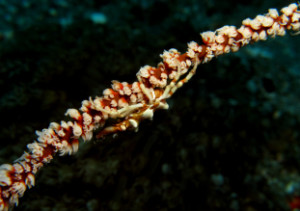 Each hour underwater at Ambon went by like lightening for me. I am not sure what kind of rating system one can apply to diving in Ambon. A star rating system does not seem accurate because it conjures up more typical images like corals and blue water and big animals and whether there is current or not. Things are not swimming around much and if they do have fins they can also have legs attached to creep around, and sometimes your photos of an odd creature inadvertently advertise Coke. I am a scientist, and I cannot help but think of evolution when I am under the water. All sorts of ideas pop into my head, like what exactly was evolution thinking, and how genetically different am I really than the rhinopias scorpionfish? To me it seems that Ambon is a collection of evolution’s experiments or abandoned ones in addition to the usual animals, and perhaps a rating system should correlate to remarkable skills of evolution at work here and your confidence level as a diver when you leave.
Each hour underwater at Ambon went by like lightening for me. I am not sure what kind of rating system one can apply to diving in Ambon. A star rating system does not seem accurate because it conjures up more typical images like corals and blue water and big animals and whether there is current or not. Things are not swimming around much and if they do have fins they can also have legs attached to creep around, and sometimes your photos of an odd creature inadvertently advertise Coke. I am a scientist, and I cannot help but think of evolution when I am under the water. All sorts of ideas pop into my head, like what exactly was evolution thinking, and how genetically different am I really than the rhinopias scorpionfish? To me it seems that Ambon is a collection of evolution’s experiments or abandoned ones in addition to the usual animals, and perhaps a rating system should correlate to remarkable skills of evolution at work here and your confidence level as a diver when you leave.
News
Diveheart to Host DEMA Exhibitor Sponsored Seminar: Build a Better Adaptive Dive Briefing

Diveheart, a global leader in adaptive scuba diving, will present “Building a Better Adaptive Dive Briefing” at the 2024 Diving Equipment and Marketing Association (DEMA) Show. This seminar will explore the critical components of creating an effective and inclusive dive briefing for adaptive divers.
Since its founding, Diveheart has revolutionized adaptive diving, offering life-changing scuba experiences to individuals with disabilities, wounded veterans, and others who face physical, mental, or emotional challenges. Diveheart’s therapeutic underwater programs help participants build confidence, independence, and a sense of freedom that goes far beyond the water.
What You’ll Learn:
- The importance of language in adaptive diving
- Detailed communication and its role in safety and success
- How to avoid making assumptions about participants’ abilities
- Effective use of Diveheart’s Adaptive Diver Profile Slate for personalized dive planning
Event Details:
- Location: Las Vegas Convention Center, Room 207, 3150 Paradise Road, Las Vegas, Nevada, USA
- Date: November 19, 2024
- Time: 10:00 AM – 11:00 AM
Who Should Attend: Divers, instructors, and dive professionals looking to enhance their adaptive diving skills and improve their briefings.
Speakers:
- Julie Smith, Diveheart Training Director
- Gabriel Espino, Diveheart Lead Instructor Trainer Examiner
- Tinamarie Hernandez, Diveheart Executive Director
About Diveheart: Diveheart, founded in 2001, is a 501(c)(3) non-profit organization dedicated to providing adaptive scuba diving programs for children, adults, and veterans with disabilities. Diveheart’s mission is to help individuals “Imagine the Possibilities” in their lives by building confidence, independence, and self-esteem through scuba diving.
Find out more about Diveheart at www.diveheart.org.
Blogs
Dive into Gibraltar: a Journey of Wrecks, Wildlife and Conservation

Diving in Gibraltar is an experience that truly sets itself apart. Situated at the confluence of the Atlantic and Mediterranean, it offers an underwater world rich in both marine life and history. Whether you’re a complete novice or a seasoned diver, Gibraltar is ready to take you on an unforgettable journey beneath the waves.
One of the most remarkable aspects of diving in Gibraltar is the artificial reef project. Over the years, several ships have been deliberately sunk to create vibrant underwater habitats. Among the most popular sites are the Spanish Barges, 482M, and Batty’s Barge, all located in the local favourite, Camp Bay. The Spanish Barges are a series of four wrecks, two of which were sunk as part of Gibraltar’s artificial reef programme in the 1980s. They rest at varying depths, ranging from 7 to 22 metres, making them accessible for divers of all skill levels. These wrecks, now teeming with marine life such as octopuses, conger eels, and nudibranchs, offer something for every diver, whether they enjoy swimming through wreckage or observing how marine species have transformed these vessels into thriving ecosystems.

For those more interested in history, Gibraltar’s waters host incredible wrecks like the SS Rosslyn and SS Excellent. The SS Rosslyn, a Cardiff-built steamer, sank in 1916 after dragging its anchor in a storm. Now lying at a depth of 23 metres, this 350-foot wreck attracts advanced divers eager to explore its remnants. Newer wrecks, like the Seahawk, sunk in 2002, and the Sun Swale, sunk in 2015, are part of Gibraltar’s ongoing reef expansion. These more recent additions are rapidly becoming important habitats, drawing species such as cuttlefish, spider crabs, and lobsters. Each of these wrecks offers divers the chance to experience a fusion of history and nature, with the wrecks evolving into vibrant marine environments over time.

Another must-see is the Seven Sisters Marine Conservation Zone (MCZ), known for its rich biodiversity and contribution to the protection of marine species. This area is located close to The Inkwells, where divers can still find remnants of 18th- and 19th-century artifacts, including ceramic pipes, gin bottles, marble fragments, and cod bottles, lending a treasure-hunting aspect to each dive. Exploring this site is like taking a step back in time while being surrounded by a thriving underwater ecosystem.

The diving conditions in Gibraltar are just as diverse as the marine life it hosts. British Gibraltar Territorial Waters is home to a wide array of species, far more life than many other areas in the Mediterranean. This impressive biodiversity is largely due to the nutrient-rich waters that flow where the Atlantic and Mediterranean meet. Divers frequently encounter octopuses—Gibraltar’s charismatic species—along with conger eels, moray eels, thornback rays, and spider crabs. Lucky divers, especially during certain times of the year, might even spot Bluefin Atlantic Tuna swimming through the bay while feeding, as well as many other pelagic species. The sheer abundance of fish and the variety of species make each dive an exciting and unique experience, offering something new with every descent.

Gibraltar boasts its accessibility to diving and a wealth of different dive sites depending on your diving abilities, qualifications and experience. The South and East side dive sites are fantastic boat dives ranging in depths from 14m to 35m + where you can dive on rocky biogenic reefs with a vast array of marine life.

You will need a permit to dive which is easily issued by the Department of the Environment or you can dive with licenced dive operators who will cover this for you. There are also very active local BSAC dive clubs you may wish to get in touch with.

Gibraltar offers a full range of diving experiences for everyone, from first-timers to seasoned veterans. Shore diving is conducted six days a week, and on Sundays, you may venture out on a boat to explore some of the more distant wrecks, such as SS Rosslyn and Sun Swale. What makes diving in Gibraltar so accessible is that all our dive sites are within a 15-minute drive/boat ride, making it easy to fit multiple dives into a single day. Whether you’re taking your first steps into the underwater world with a try dive or you’re an advanced diver looking to explore wrecks and caves, we ensure that each dive is tailored to suit your needs and experience level.

Operations start early, and by 8:45 AM, dive centre teams are already busy preparing for the day’s dives ensuring everything is in place for divers. A typical dive day begins with a briefing that covers the dive plan, safety procedures, and site management, ensuring that everyone is comfortable and prepared for the adventure ahead. Whether it’s exploring historic wrecks or spotting charismatic marine life, each dive offers something special. After the first dive, you surface, switch tanks, and enjoy a surface interval sharing stories of what has been seen before briefing up for a second dip!

In addition to providing unforgettable diving experiences, Gibraltar is deeply committed to marine conservation and scientific research working closely with the Department of the Environment and the University of Gibraltar. Under the water we facilitate the university’s research on projects including coral health assessments and the transplantation of coral species such as Astroides calycularis and various gorgonians. These efforts are critical in preserving Gibraltar’s underwater ecosystems and ensuring that future generations of divers can enjoy its incredible biodiversity. These conservation initiatives are ongoing, and there is regular collaboration with students and researchers on various dive-related projects as they begin the Thesis modules of their degrees.

Dive Charters, Gibraltar’s predominant dive centre is also involved in some octopus research, with a project aimed at increasing the octopus population in Gibraltar’s waters. Working with the University of Gibraltar and the Department of the Environment, they have installed artisanal dens designed to encourage octopus to breed and thrive in the area. These dens have proven highly successful, and divers often encounter octopuses up close in their natural habitat. Observing these intelligent, curious creatures in action is always a highlight of our dives, and their growing population is a testament to the ongoing conservation work.

Diving in Gibraltar offers an unparalleled blend of history, marine life, and conservation. Whether you’re captivated by centuries-old shipwrecks or amazed by the diversity of species that call these waters home, Gibraltar provides a diving experience like no other and we are proud to share this incredible underwater world with divers from all over the globe. Our dedication to safety, fun, and environmental responsibility ensures that each dive leaves a lasting impression.

From beginners to experienced divers, we’ve got something for everyone. With all dive sites just a short ride away the wonders of Gibraltar are waiting for you!

|
|
|
-

 Blogs2 months ago
Blogs2 months agoGozo: An Underwater Treasure Trove in the Heart of the Mediterranean
-

 News1 week ago
News1 week agoIconic SS United States to become the World’s Largest Artificial Reef
-

 Blogs2 months ago
Blogs2 months agoNovoScuba’s Game-Changing Approach for Dive Store Owners: WE PAY YOU!
-

 News1 month ago
News1 month agoBook Review – 52 Assignments: Underwater Photography
-

 News3 months ago
News3 months agoDived Up release NEW Second Edition of Diving Gozo & Comino by Richard Salter
-

 News3 months ago
News3 months agoTreasures, Shipwrecks and the Dawn of Red Sea Diving by Howard Rosenstein available now
-

 Marine Life & Conservation2 months ago
Marine Life & Conservation2 months agoBook Review: Sharkpedia
-

 Gear News4 weeks ago
Gear News4 weeks agoDYNAMICNORD – New German diving brand enters the British market


